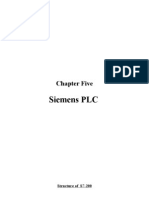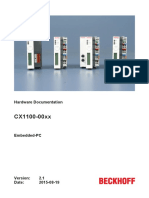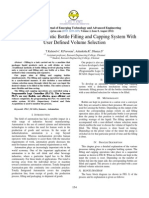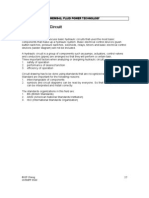PLC Primer PDF
PLC Primer PDF
Uploaded by
Anish GoswamiCopyright:
Available Formats
PLC Primer PDF
PLC Primer PDF
Uploaded by
Anish GoswamiOriginal Title
Copyright
Available Formats
Share this document
Did you find this document useful?
Is this content inappropriate?
Copyright:
Available Formats
PLC Primer PDF
PLC Primer PDF
Uploaded by
Anish GoswamiCopyright:
Available Formats
A PLC Primer
T ABLE
OF
C ONTENTS
pg 3 pg 4 pg 5 pg 7 pg 10 pg 13 pg 14 pg 15
What Is a PLC? Why Use PLCs? But What Exactly Is a PLC? A Little More About Inputs and Outputs And a Little More About the Control Program So How Does a PLC Keep All This Straight? To Sum It All Up Want To Learn More?
Industrialtext & Video Company
www.industrialtext.com
1-800-752-8398
1999 by Industrial Text & Video Company. All rights reserved.
A PLC Primer
WHAT IS A PLC?
A programmable logic controller, also called a PLC or programmable controller, is a computer-type device used to control equipment in an industrial facility. The kinds of equipment that PLCs can control are as varied as industrial facilities themselves. Conveyor systems, food processing machinery, auto assembly linesyou name it and theres probably a PLC out there controlling it. In a traditional industrial control system, all control devices are wired directly to each other according to how the system is supposed to operate. In a PLC system, however, the PLC replaces the wiring between the devices. Thus, instead of being wired directly to each other, all equipment is wired to the PLC. Then, the control program inside the PLC provides the wiring connection between the devices. The control program is the computer program stored in the PLCs memory that tells the PLC whats supposed to be going on in the system. The use of a PLC to provide the wiring connections between system devices is called softwiring.
E XAMPLE
Lets say that a push button is supposed to control the operation of a motor. In a traditional control system, the push button would be wired directly to the motor. In a PLC system, however, both the push button and the motor would be wired to the PLC instead. Then, the PLCs control program would complete the electrical circuit between the two, allowing the button to control the motor.
In a traditional system, all control devices are wired directly to each other
In a PLC system, all control devices are wired to the PLC.
PLC
Industrial Text & Video Company
1-800-752-8398
www.industrialtext.com
A PLC Primer
WHY USE PLCS?
The softwiring advantage provided by programmable controllers is tremendous. In fact, it is one of the most important features of PLCs. Softwiring makes changes in the control system easy and cheap. If you want a device in a PLC system to behave differently or to control a different process element, all you have to do is change the control program. In a traditional system, making this type of change would involve physically changing the wiring between the devices, a costly and time-consuming endeavor.
E XAMPLE
Lets say that two push buttons, PB1 and PB2, are connected to a PLC. Two pilot lights, PL1 and PL2, are also connected to the PLC. The way these devices are connected now pressing push button PB1 turns on pilot light PL1 and pressing push button PB2 turns on pilot light PL2. Lets say that you want to change this around so that PB1 controls PL2 and PB2 controls PL1. In a traditional system, you would have to rewire the circuit so that the wiring from the first push button goes to the second pilot light and vice versa. However, because these devices are connected to a PLC, making this change is as simple as making a small change in the control program.
In addition to the programming flexibility we just mentioned, PLCs offer other advantages over traditional control systems. These advantages include: high reliability small space requirements computing capabilities reduced costs ability to withstand harsh environments expandability
Industrial Text & Video Company
1-800-752-8398
www.industrialtext.com
A PLC Primer
BUT WHAT EXACTLY IS A PLC?
A PLC basically consists of two elements: the central processing unit the input/output system
The Central Processing Unit
The central processing unit (CPU) is the part of a programmable controller that retrieves, decodes, stores, and processes information. It also executes the control program stored in the PLCs memory. In essence, the CPU is the brains of a programmable controller. It functions much the same way the CPU of a regular computer does, except that it uses special instructions and coding to perform its functions. The CPU has three parts: the processor the memory system the power supply The processor is the section of the CPU that codes, decodes, and computes data. The memory system is the section of the CPU that stores both the control program and data from the equipment connected to the PLC. The power supply is the section that provides the PLC with the voltage and current it needs to operate.
The CPU has three main parts the processor the memory system and the power supply.
Processor
Memory System
CPU
Power Supply
Industrial Text & Video Company 1-800-752-8398 www.industrialtext.com 5
A PLC Primer
The Input/Output System
The input/output (I/O) system is the section of a PLC to which all of the field devices are connected. If the CPU can be thought of as the brains of a PLC, then the I/O system can be thought of as the arms and legs. The I/O system is what actually physically carries out the control commands from the program stored in the PLCs memory. The I/O system consists of two main parts: the rack I/O modules The rack is an enclosure with slots in it that is connected to the CPU. I/O modules are devices with connection terminals to which the field devices are wired. Together, the rack and the I/O modules form the interface between the field devices and the PLC. When set up properly, each I/O module is both securely wired to its corresponding field devices and securely installed in a slot in the rack. This creates the physical connection between the field equipment and the PLC. In some small PLCs, the rack and the I/O modules come prepackaged as one unit.
1 2 3
A rack is an enclosure with slots
into which I/O modules
1 2 3
are installed.
Industrial Text & Video Company
1-800-752-8398
www.industrialtext.com
A PLC Primer
A LITTLE MORE ABOUT INPUTS
AND
All of the field devices connected to a PLC can be classified in one of two categories: inputs outputs Inputs are devices that supply a signal/data to a PLC. Typical examples of inputs are push buttons, switches, and measurement devices. Basically, an input device tells the PLC, Hey, somethings happening out hereyou need to check this out to see how it affects the control program. Outputs are devices that await a signal/data from the PLC to perform their control functions. Lights, horns, motors, and valves are all good examples of output devices. These devices stay put, minding their own business, until the PLC says, You need to turn on now or Youd better open up your valve a little more, etc.
OUTPUTS
E XAMPLE
An overhead light fixture and its corresponding wall switch are good examples of everyday inputs and outputs. The wall switch is an inputit provides a signal for the light to turn on. The overhead light is an outputit waits until the switch sends a signal before it turns on. Lets pretend that you have a souped-up overhead light/switch circuit that contains a PLC. In this situation, both the switch and the light will be wired to the PLC instead of to each other. Thus, when you turn on the switch, the switch will send its turn on signal to the PLC instead of to the light. The PLC will then relay this signal to the light, which will then turn on.
An input device sends a signal to a PLC...
PLC
An output device receives a signal from a PLC.
Industrial Text & Video Company
1-800-752-8398
www.industrialtext.com
A PLC Primer
There are two basic types of input and output devices: discrete analog Discrete devices are inputs and outputs that have only two states: on and off. As a result, they send/receive simple signals to/from a PLC. These signals consist of only 1s and 0s. A 1 means that the device is on and a 0 means that the device is off. Analog devices are inputs and outputs that can have an infinite number of states. These devices can not only be on and off, but they can also be barely on, almost totally on, not quite off, etc. These devices send/receive complex signals to/from a PLC. Their communications consist of a variety of signals, not just 1s and 0s.
E XAMPLE
The overhead light and switch we just discussed are both examples of discrete devices. The switch can only be either totally on or totally off at any given time. The same is true for the light. A thermometer and a control valve are examples of the other type of I/O devicesanalog. A thermometer is an analog input device because it provides data that can have an infinite number of states. Temperature isnt just hot or cold. It can have a variety of states, including warm, cool, moderate, etc. A control valve is an analog output for the same reason. It can be totally on or totally off, but it can also have an infinite number of settings between these two states.
A discrete device can only be on or off
On
On
Off
Dim
Off
An analog device can be either on, off, or anywhere in between.
Industrial Text & Video Company
1-800-752-8398
www.industrialtext.com
A PLC Primer
Because different input and output devices send different kinds of signals, they sometimes have a hard time communicating with the PLC. While PLCs are powerful devices, they cant always speak the language of every device connected to them. Thats where the I/O modules we talked about earlier come in. The modules act as translators between the field devices and the PLC. They ensure that the PLC and the field devices all get the information they need in a language that they can understand.
Industrial Text & Video Company
1-800-752-8398
www.industrialtext.com
A PLC Primer
AND A LITTLE MORE ABOUT
THE
We talked a little bit earlier about the control program. The control program is a software program in the PLCs memory. Its what puts the control in a programmable controller. The user or the system designer is usually the one who develops the control program. The control program is made up of things called instructions. Instructions are, in essence, little computer codes that make the inputs and outputs do what you want in order to get the result you need. There are all different kinds of instructions and they can make a PLC do just about anything (add and subtract data, time and count events, compare information, etc.). All you have to do is program the instructions in the proper order and make sure that they are telling the right devices what to do and voila!you have a PLC-controlled system. And remember, changing the system is a snap. If you want the system to act differently, just change the instructions in the control program. Different PLCs offer different kinds of instructions. Thats part of what makes each type of PLC unique. However, all PLCs use two basic types of instructions: contacts coils Contacts are instructions that refer to the input conditions to the control programthat is, to the information supplied by the input field devices. Each contact in the control program monitors a certain field device. The contact waits for the input to do something in particular (e.g., turn on, turn off, etc.this all depends on what type of contact it is). Then, the contact tells the PLCs control program, The input device just did what its supposed to do. Youd better check to see if this is supposed to affect any of the output devices.
CONTROL PROGRAM
Industrial Text & Video Company
1-800-752-8398
www.industrialtext.com
10
A PLC Primer
Coils are instructions that refer to the outputs of the control programthat is, to what each particular output device is supposed to do in the system. Like a contact, each coil also monitors a certain field device. However, unlike a contact, which monitors the field device and then tells the PLC what to do, a coil monitors the PLC control program and then tells the field device what to do. It tells the output device, Hey, the PLC just told me that the switch turned on. That means that youre supposed to turn on now. So lets go!
E XAMPLE
Lets talk again about that souped-up switching circuit, in which a wall switch and an overhead light are connected to a PLC. Lets say that turning on the switch is supposed to turn on the light. In this situation, the PLCs control program would contain a contact that examines the input devicethe wall switchfor an on condition and a coil that references the light. When the switch turns on, the contact will energize, meaning that it will tell the PLC that the condition its been looking for has happened. The PLC will relay this information to the coil instruction by energizing it. This will let the coil know that it needs to tell its referenced outputthe lightto turn on.
On or Off?
A contact is a computer code that monitors the status of an input
Contact
On or Off?
A coil is a computer code that monitors the status of an output.
Coil
Industrial Text & Video Company
1-800-752-8398
www.industrialtext.com
11
A PLC Primer
In PLC talk, this three-step process of monitoring the inputs, executing the PLC control program, and changing the status of the outputs accordingly is called the scan.
During the scan, a PLC
Monitor Inputs
checks the inputs
Scan
Execute Program
executes the control program
Change Outputs
and updates the outputs.
Industrial Text & Video Company
1-800-752-8398
www.industrialtext.com
12
A PLC Primer
SO HOW DOES A PLC KEEP ALL THIS STRAIGHT?
A PLCs memory system is very complex, allowing it to store information not only about the control program but about the status of all the inputs and outputs as well. To keep track of all this information, it uses a system called addressing. An address is a label or number that indicates where a certain piece of information is located in a PLCs memory. Just like your home address tells where you live in your city, a device or piece of datas address tells where information about it resides in the PLCs memory. That way, if a PLC wants to find out information about a field device, it knows to look in its corresponding address location. Some addresses contain information about the status of particular field devices. Other addresses store data thats the result of control program computations. Still others contain reference data entered by the system programmer. Nonetheless, no matter what type of data it is, a PLC uses its addressing scheme to keep track of it all. That way, itll have the right data when it needs it.
Just like your address tells where you can be found in your city
Anywhere, USA
You are here.
A devices address tells where it can be found in the PLCs memory.
PLC Memory
The data is here.
Industrial Text & Video Company
1-800-752-8398
www.industrialtext.com
13
A PLC Primer
TO SUM IT ALL UP
PLCs can seem a little daunting at first, but theres no need to panic. Just remember that all PLCs follow the basic rules of operation weve just discussed. All PLCs have a CPU and an input/output system. They also all use a control program, instructions, and addressing to make the equipment in the control system do what its supposed to do. And no matter how many bells and whistles you add to it, every PLC does the same three things: (1) examines its input devices, (2) executes its control program, and (3) updates its output devices accordingly. So in reality, understanding PLCs is as simple as 1-2-3!
Industrial Text & Video Company
1-800-752-8398
www.industrialtext.com
14
A PLC Primer
WANT TO LEARN MORE?
ABT-ITV900
Industrial Text and Video offers a wide selection of training and reference materials in both PLCs and Electrical and Motor Controls to help you expand your knowledge. All of our packages contain videos, reference books, and computer software to help you grasp the essential details of each topic. Basic Introduction to PLCs Video Training Series
Designed for maintenance personnel, this PLC course covers the basic operation of PLCs, as well as all the critical maintenance functions, such as troubleshooting the PLC and I/O system and preventive maintenance.
ABT-ITV500
Advanced PLC Video Training Series
A comprehensive PLC program thats applicable to all makes and models of PLCs. With ten videos, computer software, and three reference books, this series has everything needed to become a PLC expert.
ABT-ITV1761
MicroLogix 1000 Controller Total Training Series
This nine-tape program is designed to help electrical maintenance personneleven those without any prior PLC knowledgeunderstand, program, and troubleshoot the MicroLogix 1000 controller.
ABT-ITV700
Electrical and Motor Controls Video Training Series
Grasp the most critical and fundamental skills in the five most important electrical maintenance areaspower distribution, PLC technology, sensor and components, ladder diagrams, and motor controls. The packages are available individually or as a complete series.
ABT-ITV206BOOK
Programmable Controllers: Theory and Implementation, 2nd Edition
Written by industry experts, this 1035-page reference covers important, up-to-date, real world programmable controller topics and applications. Its a generic PLC reference tool that will help you with all of the different makes and models of PLCs in your facility.
ABT-ITV206WKBK
Programmable Controllers: Workbook and Study Guide
With over 800 questions and answers, this companion workbook is the perfect quick-reference tool.
For more information, contact Industrial Text & Video:
By Phone: 800-752-8398 By Fax: 770-240-2209 By Mail: 1950 Spectrum Cir., Tower A1st Floor, Marietta GA 30067 By E-mail: sales@industrialtext.com Industrial Text & Video Company 1-800-752-8398 www.industrialtext.com 15
1950 Spectrum Cir., Tower A1st Floor, Marietta, GA 30067 Phone: 800-752-8398 Fax: 770-240-2209
You might also like
- Analog Modules: SiemensDocument8 pagesAnalog Modules: SiemensSofiane Benseghir100% (3)
- Simatic HmiDocument324 pagesSimatic HmiAyman ElotaifyNo ratings yet
- Thomson Electrac HD Linear Actuator Motion Control per CAN BusFrom EverandThomson Electrac HD Linear Actuator Motion Control per CAN BusNo ratings yet
- Ladder Logic Contacts and CoilsDocument20 pagesLadder Logic Contacts and CoilsInstrumentation ToolsNo ratings yet
- S7-300 Module DataDocument676 pagesS7-300 Module DatagustavoNo ratings yet
- 3 PLC Programming ConsiderationsDocument10 pages3 PLC Programming ConsiderationsEliel BascoNo ratings yet
- Programmable Logic Controller (PLC) - Industrial Wiki - ODESIE® by Technology TransferDocument41 pagesProgrammable Logic Controller (PLC) - Industrial Wiki - ODESIE® by Technology TransferAbhishek SinghNo ratings yet
- Siemens PLC: Chapter FiveDocument25 pagesSiemens PLC: Chapter FiveplcmanaNo ratings yet
- RSLogix 500 EtherNet-IP Logic Examples PDFDocument4 pagesRSLogix 500 EtherNet-IP Logic Examples PDFchapsboiNo ratings yet
- 05 - DC Motor Control Using PLCDocument49 pages05 - DC Motor Control Using PLCKoppoju PadmaNo ratings yet
- Integrating Rockwell Automation With FestoDocument16 pagesIntegrating Rockwell Automation With FestoJesús Navarro GarciaNo ratings yet
- In The Name of Allah The Most Benificet and The Most MercifulDocument24 pagesIn The Name of Allah The Most Benificet and The Most MercifulAsad RazaNo ratings yet
- The New Blow Moulding Machine For The Production of PET ContainersDocument11 pagesThe New Blow Moulding Machine For The Production of PET ContainersSundar MoorthiNo ratings yet
- Servo Valve CircuitDocument10 pagesServo Valve Circuitsingh1582100% (1)
- CX1100-00xx: Hardware DocumentationDocument78 pagesCX1100-00xx: Hardware DocumentationThiago FernandesNo ratings yet
- Siemens Simatic S 7 300 - 400 - PID Control EnglishDocument42 pagesSiemens Simatic S 7 300 - 400 - PID Control Englishduniaengineering8666100% (15)
- Error & Troubleshooting: SiemensDocument27 pagesError & Troubleshooting: SiemensSofiane Benseghir100% (1)
- PLC BasicDocument25 pagesPLC BasicChristian MartínezNo ratings yet
- PLC Based Water Bottle Filling and Caping SystemDocument4 pagesPLC Based Water Bottle Filling and Caping SystemSajid BashirNo ratings yet
- Siemens PLC Programming Example1 PDFDocument12 pagesSiemens PLC Programming Example1 PDFHani ErrachidNo ratings yet
- TroubleshootingDocument24 pagesTroubleshootingAamer Khawaja100% (1)
- Iec61131 3Document37 pagesIec61131 3spfallasNo ratings yet
- Course Description SMSCP L2Document2 pagesCourse Description SMSCP L2Zdravko PeranNo ratings yet
- Pneumatics ElectropneumaticsDocument44 pagesPneumatics ElectropneumaticswanNo ratings yet
- Automatic Control of Hydraulic Machine Using PLCDocument5 pagesAutomatic Control of Hydraulic Machine Using PLCIJSTENo ratings yet
- Types Profibus CommunicationDocument23 pagesTypes Profibus CommunicationAhmed ElsayedNo ratings yet
- Industrial Communication SystemsDocument339 pagesIndustrial Communication Systemspvtrong.sdh212No ratings yet
- CodesysDocument22 pagesCodesysJacob B ChackoNo ratings yet
- Chapter 7 - Hydraulic Operation Circuit and ApplicationDocument19 pagesChapter 7 - Hydraulic Operation Circuit and ApplicationMuhammad AbdullahNo ratings yet
- s7-200 SMART System Manual en-USDocument866 pagess7-200 SMART System Manual en-USvăn nguyễn100% (1)
- Process Control Instrumentation, Troubleshooting and Problem SolvingDocument4 pagesProcess Control Instrumentation, Troubleshooting and Problem SolvinghafizahNo ratings yet
- PLC Troubleshooting: Troubleshooting Inputs and OutputsDocument5 pagesPLC Troubleshooting: Troubleshooting Inputs and OutputsMd Omar FaruqueNo ratings yet
- Chapter 1 NotesDocument3 pagesChapter 1 Noteshero_spaceboy3600No ratings yet
- Industrial PLC NotesDocument101 pagesIndustrial PLC Noteshoseah mwanzahNo ratings yet
- Making Tomorrow's Workforce Fit For The Future of Industry: Siemens Mechatronic Systems Certification Program (SMSCP)Document6 pagesMaking Tomorrow's Workforce Fit For The Future of Industry: Siemens Mechatronic Systems Certification Program (SMSCP)Shobanraj LetchumananNo ratings yet
- Automation Chapter 5Document65 pagesAutomation Chapter 5Owais Gharaibeh100% (2)
- Volume 4 Circuit ProtectionDocument684 pagesVolume 4 Circuit ProtectionHugo Dennis Mattos EspinozaNo ratings yet
- Automating With PROFINET Industrial Communication Based On Industrial Ethernet PDF Download Free OnlineDocument1 pageAutomating With PROFINET Industrial Communication Based On Industrial Ethernet PDF Download Free OnlineLavrenty LavrentiNo ratings yet
- Logix Wp008 en PDocument27 pagesLogix Wp008 en PAnonymous YhFsrjunV0No ratings yet
- 2013 - 14 HydraulicsDocument122 pages2013 - 14 HydraulicsStroia Constantin Marius100% (1)
- Basic Hydraulic Circuits - AnalysisDocument49 pagesBasic Hydraulic Circuits - AnalysisMohamed Zahran100% (1)
- Mc-Simotion Scout ConfiguringDocument298 pagesMc-Simotion Scout ConfiguringBruno Moraes100% (1)
- Instant PLC Programming with RSLogix 5000: Learn how to create PLC programs using RSLogix 5000 and the industry's best practices using simple, hands-on recipesFrom EverandInstant PLC Programming with RSLogix 5000: Learn how to create PLC programs using RSLogix 5000 and the industry's best practices using simple, hands-on recipesNo ratings yet
- PLC and HMI Development with Siemens TIA Portal: Develop PLC and HMI programs using standard methods and structured approaches with TIA Portal V17From EverandPLC and HMI Development with Siemens TIA Portal: Develop PLC and HMI programs using standard methods and structured approaches with TIA Portal V17No ratings yet
- Fundamentals of PLC FinalDocument117 pagesFundamentals of PLC FinalBellum LetaleNo ratings yet
- Fundamentals of PLC FinalDocument117 pagesFundamentals of PLC FinalTetsusaiga100% (1)
- Chapter 3 Introduction To PLC SystemDocument26 pagesChapter 3 Introduction To PLC SystemMuhammad AniqNo ratings yet
- 0 PLC HandbookDocument4 pages0 PLC Handbooknawaf salehNo ratings yet
- PLCDocument13 pagesPLCChalez ZengeretsiNo ratings yet
- PNEUMATICSDocument33 pagesPNEUMATICSAllysa Grace SobradoNo ratings yet
- PLC BasicsDocument53 pagesPLC Basicsssservice centreNo ratings yet
- Programmable Logic Controller Thesis PDFDocument6 pagesProgrammable Logic Controller Thesis PDFBestEssayHelpIndianapolis80% (5)
- Programmable Logic Controllers (PLCS) : Basics, Types & ApplicationsDocument19 pagesProgrammable Logic Controllers (PLCS) : Basics, Types & ApplicationsAmol PatilNo ratings yet
- PLC Basics Tutorial: What Is A PLC?Document6 pagesPLC Basics Tutorial: What Is A PLC?nov17muraliNo ratings yet
- PLC BasicsDocument19 pagesPLC BasicshemantkumarsheteNo ratings yet
- What Is A PLC-introductionDocument18 pagesWhat Is A PLC-introductionUma100% (1)



























































